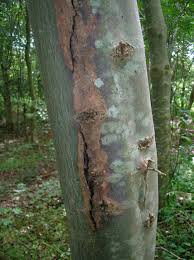During the winter season, trees are vulnerable to a number of injuries. One of the more common is a bark injury called winter sunscald.
What Is Sunscald?
Winter sunscald, also called southwest injury, is a type of winter injury that affects the trunks and limbs of certain deciduous trees. It is the result of bark exposure to fluctuating temperatures during the winter months.
What Are the Effects of Sunscald?
Sunscald refers to a process in which living cells within the outer bark break dormancy, and are either damaged or killed by a sudden drop in temperature. Sunscald tends to develop on the side of trees most prone to sun exposure. Direct sunlight or sunlight reflected from snow or light colored structures heats the outer bark during the day, causing an increase in the bark temperature. This stimulates the dormant cells, causing them to become active. Once the sun sets, the temperature drops, resulting in a rapid cooling of the outer bark. The sudden shift in temperature shocks the live cells, inducing massive damage, or in more severe cases, death.
When a tree has experienced sunscald, the affected bark slowly darkens, turning a reddish-brown color. The bark then thickens, becoming rough and hard. Eventually the callused tissue cracks and falls away, revealing the damaged inner layers. Sometimes only the outermost cambium layer is damaged, and a sunken area will gradually appear on the trunk.
Sunscald can become a significant stressor for trees, resulting in stem dieback and stunted growth. It can also lead to bark cracking, and the formation of cankers on the tree. Affected trees tend to have sparse foliage, and will often exhibit signs of decay.
What Trees Are Most Susceptible?
Tree species that have thin bark are the most susceptible to sunscald. These include mountain ash, oak, maple, cottonwood, birch, beech, willow, linden and honey locust, as well as most fruit trees. Younger trees are also susceptible due to their thin bark, and soft exterior.
Newly planted trees that have not yet established a strong root system are more susceptible to sunscald and other winter injuries, such as frost cracking or frost heaving. Trees that are not sufficiently hydrated, or have experienced an extended period of drought are also susceptible to sunscald.
Prevention & Management:
Insulate the trunk and lower branches of any susceptible trees with white tree wrap. This is especially important for those with south or west exposure. Tree wrap reflects any direct sunlight away from the protected areas, insulating the bark, and helping to maintain a steady surface temperature. This enables the cells to remain dormant, lessening the risk of them being injured once temperatures decline. Tree wrap should be applied in late fall before the temperature drops below freezing. They can be removed in spring, once temperatures become consistently mild.
Trees and limbs can also be insulated with a light-colored board or fence. These should be installed to the south or west of the tree, where sunlight is more constant. The board or fence will provide shade for the tree, and help to keep the bark surface cooler.
Trees should be watered consistently until the ground freezes. A layer of organic mulch can also be applied around the base of the tree. This will help conserve soil moisture and moderate soil temperature. It will also help prevent nutrient deficiencies in the tree.
Avoid excessive pruning of the tree canopy. If too many lower branches are removed, the bark will become exposed to dry winds and direct sunlight.
In the event that a tree has been affected by sunscald, prune the dead bark back to any live tissue, while rounding off any sharp corners with a knife to facilitate healing. Damaged tissue often acts as a conduit for insects and tree pathogens. Applying a fungicide to the affected area can help prevent fungal infections.
Photo courtesy of Roger Griffith


